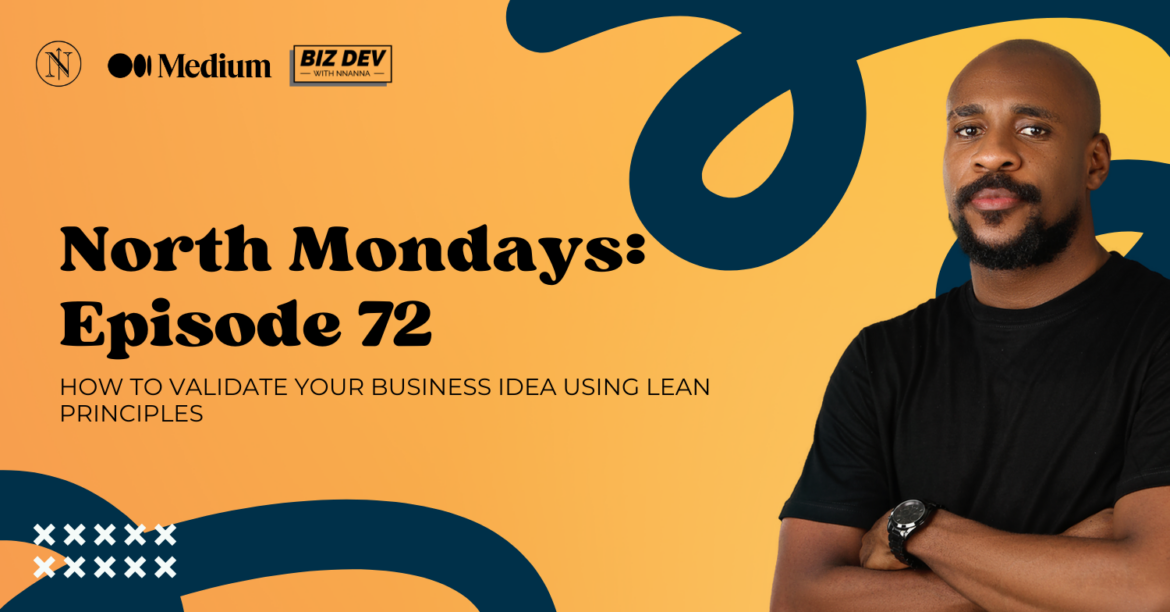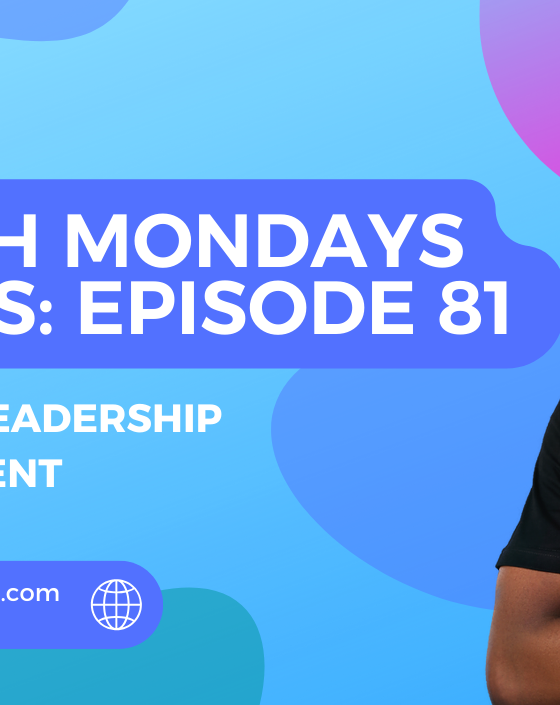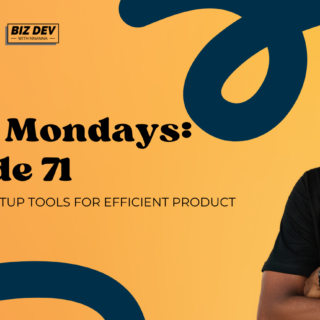How to Validate Your Business Idea Using Lean Principles
North Mondays Series: Episode 72

Are you sitting on a business idea but unsure whether it’s worth pursuing? Every entrepreneur faces this dilemma. The fear of failure can be paralyzing, especially when your time, money, and resources are on the line. This is where Lean Startup principles come into play, offering a systematic approach to validate your business idea before going all in.
Imagine knowing with confidence that your business idea meets a genuine need in the market. The Lean Startup methodology provides tools and techniques to test your assumptions and gather real-world feedback quickly and efficiently. This way, you avoid costly mistakes and invest your efforts in a direction that’s more likely to succeed.
Today, in Episode 72 of our North Mondays Series, we’ll guide you through the steps to validate your business idea using Lean principles. We’ll explore methods such as customer interviews, building a minimum viable product (MVP), and running experiments to gather actionable insights. These strategies will help you refine your idea, understand your market, and increase your chances of success.
Ready to take the first step towards validating your business idea? Dive into this episode now and learn how to apply Lean Startup principles to test your concept before you build. Don’t let uncertainty hold you back—start with confidence and clarity. Read on to unlock the key strategies for turning your idea into a validated business opportunity! 🌟
Want to dive deeper into mastering the art of business validation? Check out my comprehensive online course, “Biz Dev with Nnanna,” where we explore these strategies in detail and provide actionable insights to guide you on your entrepreneurial journey.
Introduction: Why Validate Your Business Idea?
Welcome back to the North Mondays Series, where we deliver actionable insights to help you succeed in your entrepreneurial journey! 🚀 In our last episode, we covered the top tools for Lean Startups, helping you build products more efficiently. Today, in Episode 72, we focus on a critical aspect of entrepreneurship: validating your business idea using Lean principles.
Validating your idea means testing its feasibility in the real world to ensure there’s a genuine demand for what you’re offering. Let’s explore how you can use Lean methodologies to validate your business idea effectively.
Understanding the Problem: The First Step to Validation
Before you can validate a solution, you need to ensure you’re solving a real problem. Start by identifying a specific problem that potential customers face. Conduct market research and engage in conversations with your target audience to understand their pain points.
Why this is crucial for Lean Startups:
- Helps you avoid building a product that nobody wants.
- Provides a clear focus on customer needs, guiding your product development.
- Sets the foundation for all subsequent validation steps.
Conducting Effective Customer Interviews
Customer interviews are a cornerstone of Lean Startup methodology. Directly talking to potential customers allows you to gather qualitative data about their needs, preferences, and behaviors. These interviews should be open-ended to encourage participants to share their thoughts freely.
How to effectively conduct customer interviews:
- Prepare a set of open-ended questions focusing on the problem, not your solution.
- Aim to understand the frequency and intensity of the problem.
- Avoid leading questions that might bias responses.
Hypothesis Development: Defining Your Assumptions
Based on your problem identification and customer interviews, formulate a hypothesis about your business idea. This hypothesis should outline the core assumptions about your product or service, such as its value proposition, target market, and potential solution.
Why forming a hypothesis is important:
- Provides a clear statement that you can test through experiments.
- Helps you focus on validating the most critical aspects of your business idea.
- Sets measurable goals for testing your assumptions.
Building Your MVP: Keep It Simple
An MVP is a simplified version of your product that includes just enough features to validate your hypothesis. The goal is to learn from your MVP with the least amount of effort and cost. This allows you to test your core assumptions quickly and efficiently.
Tips for creating an effective MVP:
- Focus on the single most important feature that addresses the core problem.
- Keep it simple and avoid over-engineering or adding unnecessary features.
- Use the MVP to gather feedback and iterate based on real user interactions.
Experimentation: Testing Your Hypothesis
With your MVP ready, it’s time to run experiments to test your hypothesis. This could involve A/B testing, landing page tests, or direct user feedback sessions. The key is to observe how real users interact with your MVP and to learn from their behaviors.
Steps for running effective experiments:
- Define clear objectives for what you want to learn from each experiment.
- Collect both qualitative and quantitative data to understand user behavior.
- Use feedback to refine your MVP and validate or adjust your hypothesis.
Analyzing Your Results: Learn and Adapt
After collecting data from your experiments, analyze the results to understand whether your assumptions hold true. Are users finding value in your MVP? Are they willing to pay for your solution? Use these insights to decide whether to pivot or persevere.
How to analyze your experiment results effectively:
- Look for patterns in user feedback and behavior that validate or contradict your assumptions.
- Measure key metrics such as user engagement, satisfaction, and conversion rates.
- Be ready to pivot if the results show a lack of interest or need for your product.
Pivoting vs. Persevering: Deciding Your Next Steps
Based on your findings, you may need to pivot (change your approach) or persevere (continue refining your idea). A pivot might mean targeting a different customer segment, altering your product’s features, or even changing your business model entirely.
Indicators that you might need to pivot:
- Persistent lack of interest from your target audience despite multiple iterations.
- Feedback indicating a different pain point than initially assumed.
- Market data suggesting better opportunities elsewhere.
Iteration: Continuous Improvement and Optimization
Lean Startup is all about continuous improvement. Use the feedback and data from your validation process to refine your idea, MVP, and overall strategy. Each iteration should bring you closer to a product that resonates with your market.
Why iteration is key to Lean Startups:
- Allows you to adapt to new insights and market demands.
- Minimizes waste by focusing on what truly matters to customers.
- Encourages a culture of learning and agility within your team.
Conclusion: Start Your Validation Journey Today
Validating your business idea using Lean principles is crucial to building a successful startup. By starting with problem identification, conducting customer interviews, and using MVPs to test your hypotheses, you can reduce risks and make informed decisions. Remember, the goal is not to perfect your product from the outset but to learn and adapt quickly based on real-world feedback.
Join the Conversation: Share Your Experiences
Stay tuned for more insights and strategies in the next episode of the North Mondays Series. Until then, keep testing, learning, and innovating! 🌟
Did you find this episode helpful? Share your thoughts and experiences in the comments below! Don’t forget to subscribe to “Biz Dev with Nnanna” for more episodes and actionable insights.
#LeanStartup #BusinessIdeaValidation #NorthMondays #BizDevWithNnanna #Entrepreneurship #StartupSuccess #Innovation
FAQs
How do you validate business ideas?
Validating a business idea involves several steps to ensure there is a genuine demand for your product or service. This includes conducting market research, interviewing potential customers, developing a hypothesis, building a Minimum Viable Product (MVP), and running experiments to gather feedback. The goal is to test assumptions quickly and efficiently to refine the idea or pivot if necessary.
What are the 7 practical steps to validate your idea and product?
- Identify the problem you are solving.
- Conduct market research and customer interviews.
- Formulate a hypothesis about your product’s value proposition.
- Build a Minimum Viable Product (MVP).
- Run experiments to test your hypothesis.
- Analyze results and gather feedback.
- Decide whether to pivot or persevere based on the findings.
What is the lean validation approach?
The lean validation approach is a method that focuses on testing business ideas quickly and cost-effectively using minimal resources. It emphasizes building an MVP to validate core assumptions and uses iterative cycles of experimentation and feedback to refine the product or service. This approach reduces the risk of failure by ensuring that the product meets market needs before a full-scale launch.
How do I test my business idea?
To test your business idea, start by identifying the problem your idea aims to solve. Conduct interviews with potential customers to gather insights about their needs and preferences. Develop an MVP and run experiments such as A/B tests, surveys, or landing page tests to gather real-world feedback. Use this feedback to validate or adjust your hypothesis and decide whether to move forward with your idea.
What is the idea validation method?
The idea validation method involves a structured approach to testing the feasibility of a business idea. This method includes identifying a problem, conducting market research, developing a hypothesis, creating an MVP, testing the MVP through experiments, and analyzing the results. The aim is to gather evidence that confirms or disproves the viability of the idea, allowing you to make informed decisions about moving forward.










Recent Comments